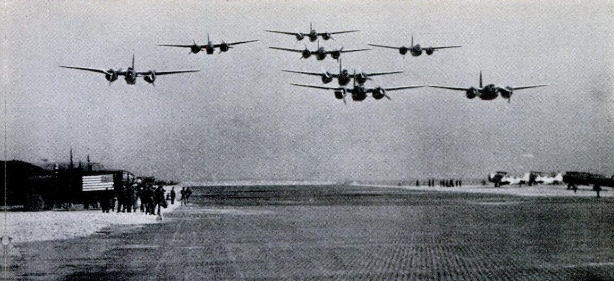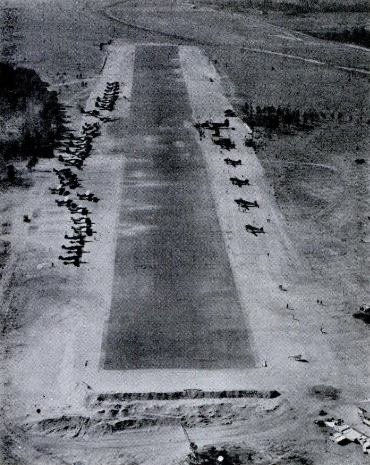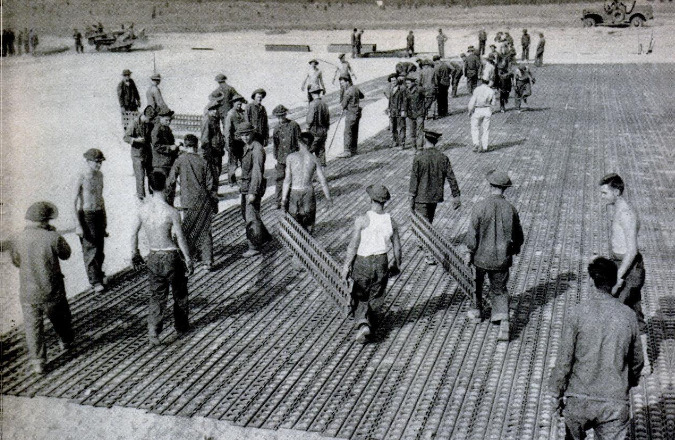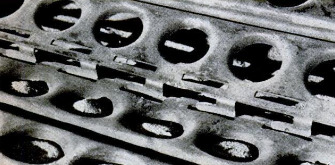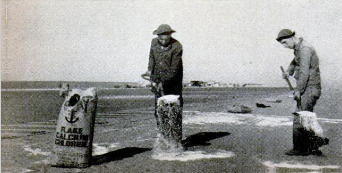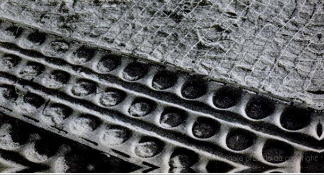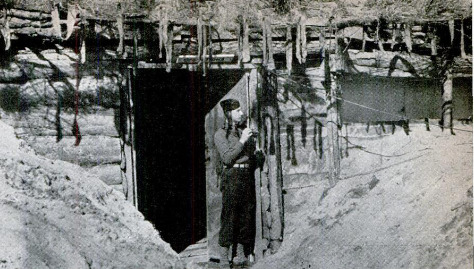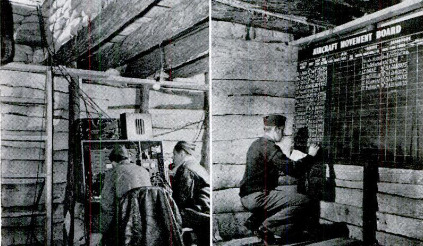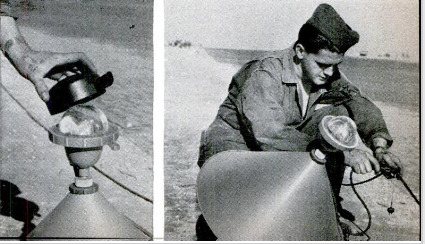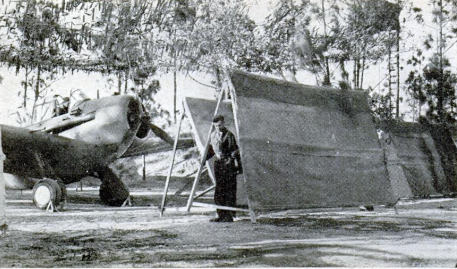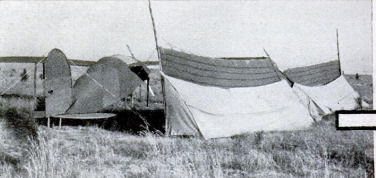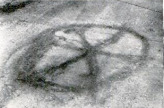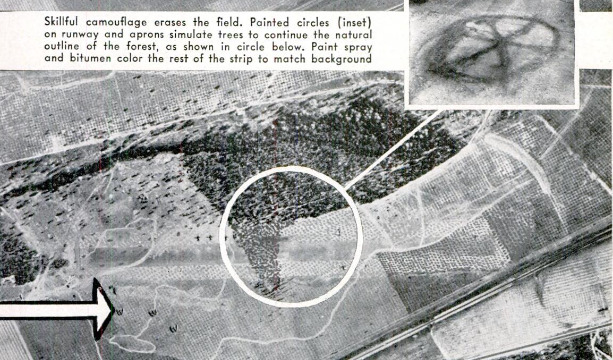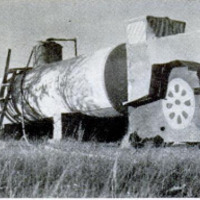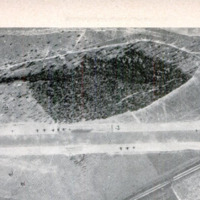-
Title (Dublin Core)
-
Short order airports
-
Article Title and/or Image Caption (Dublin Core)
-
Title: Short order airports
-
extracted text (Extract Text)
-
Lightweight steel strips and chicken wire from temporary fields for fighter planes
THE FIRST military objective
in today’s type of battle is to
establish local air superior-
ity by obtaining aviation fields
close to the actual scene of com-
bat and by destroying the enemy
flying fields in that area. Engi-
neers of the Army Air Corps have
made a tremendous stride toward
this end with the development of
a portable steel landing mat which
can be installed as a usable mili-
tary airport in less than two days,
and repaired within a few min-
utes after bombing.
The steel landing field, installed
and tested at Marston, N. C., dur-
ing recent Army maneuvers, was
called “the year's greatest
achievement in aviation” by Maj.
Gen. Henry H. Arnold, head of the
Air Corps.
So simple is its construction
that it can be easily mass pro-
duced; so simple its transporta-
tion and installation that any strip of fairly
level ground, such as a South Pacific beach
front, can be turned into a hard-surfaced
airdrome almost overnight.
This may mean that the American Fleet,
advancing against the Japanese, will not
have to depend entirely on carrier-borne air-
craft. Certainly it means that an American
army moving forward in such terrain, for
instance, as the Libyan desert, can rapidly
lay landing fields as it goes, like stepping-
stones. The mat weighs only about 1,000
tons. It is transported in small units, such
as might easily be lightered ashore for a
landing from a supply ship accompanying
an expeditionary force.
Marston Strip, as the North Carolina in-
stallation was called, was a level steel sur-
face 3,000 feet long and 150 feet wide. It
was used by all types of military planes,
from the hottest pursuit ships up to the
four-engined B-24 bomber.
Its installation by the
2nd Battalion, 21st Engi-
neers (Aviation) required
11 days, but most of this
was consumed in grading
the strip to a width of 350
feet. Actual laying of the
steel mat took only 60
hours, with three compa-
nies of 150 men each work-
ing around the clock in
eight-hour shifts. On a
beach job, with little grad-
ing required, it would be
quite possible to lay a
2,000-foot strip, 100 feet
wide, from which fighter
planes could commence operations, in a good
deal less than 24 hours.
Military planes need a long runway, but
they can use a narrow strip, which does not
have to run into the wind. With their high
landing speed, they can take off and land in
transverse winds which would ground planes
of lower wing loading. Since there is no need
to wait for concrete to dry, the portable
strip can be used by fighter planes even be-
fore it is completely laid.
A vast amount of calculation and experi-
ment doubtless went into the de-
signing of this mat, but the end
result is of exquisite simplicity.
The unit is a panel of light-gauge
sheet steel. For lightness and
braking friction each panel is
perforated. Hooked together, the
joints are loose and flexible; but
When properly engaged and laid
out flat, the plates are wedged
apart into a tight rigidity.
In the design of this basic
unit, as in all other details, the
portable landing field aims at
simplicity and adaptability to a
wide range of conditions. It can
be transported easily either by
water or by land, and its instai-
lation requires a minimum of
skilled labor and heavy equip-
ment that might not always
be available at the scene -of
operations.
Vertical flanges not only con-
tribute to the weight-resist-
ing strength of the plates, but
also bite into the ground and
keep the mat from slipping un-
der the strain of braking wheels.
In case of a bomb hit, it is possible to fill
the crater with dirt and replace the de-
stroyed plates within a few minutes.
The 2nd Battalion, under Maj. Carron M.
Borror, developed a high degree of team-
work in laying the mat. This work started
at the center of the field, while grading ma-
chinery was still working toward the ends.
Once two rows of plates had been laid across
the field, at right angles to the line of traffic,
it was possible for each company to work
in two gangs of 75 men each, working out
from the center. Each gang was divided
into three crews: one to truck the plates
from the 18 flat cars which had brought
them to Marston and slip them off on the
field at regular intervals; another to en-
gage the plates and lay them; another fol-
lowing up to pound in the clips.
One gang of 75 attained a top speed of
four rows across the field—that is, five linear
feet—in five minutes.
Once the strip had been laid, most of the |
engineers departed on other missions, while
Company D remained, under Capt. H. G.
‘Woodbury, to continue development of cam- |
ouflage and sandbag revetments for the
storage and servicing of planes, and experi-
ments with soil stabilization on the aprons
along the sides of the field.
Along each side of the strip was 100 feet
of newly graded sandy soil, which swirled
into vast clouds of dust from the prop wash
of planes warming up. Various methods of
tying down and hardening this soil were
tried, each of which might be adapted to
operations in a different locality. One sec-
tion was surfaced with a mixture of clay
and gravel, just enough clay to bind the soil
without getting soupy when wet. Next to
this soil cement was used. This binder,
which may also be used to make emergency
landing fields, is made by sprinkling cement
on the surface, mixing it into the soil with
a disk harrow, then packing and wetting.
This is especially useful with sandy soil. In
front of two revetments where airplanes
were rolled in for service, the soft sand was
held by a method developed by the British in
Egypt. Here the sand was simply covered
by strips of ordinary chicken wire, woven
together and tied down by single strands of
-
Language (Dublin Core)
-
Eng
-
Date Issued (Dublin Core)
-
1042-03
-
pages (Bibliographic Ontology)
-
101-105
-
Rights (Dublin Core)
-
Public domain
-
Archived by (Dublin Core)
-
Sami Akbiyik
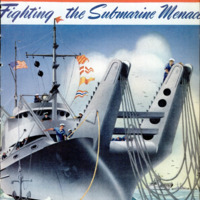 Popular Science Monthly, v. 140, n. 3, 1942
Popular Science Monthly, v. 140, n. 3, 1942

